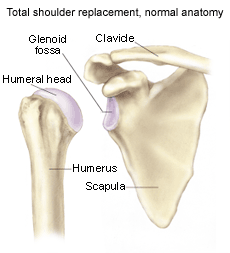     

Shoulder Arthroplasty (Replacement)
Arthroplasty is the most definitive method to manage the pain associated
with severe glenohumeral arthritis. Since 1893, when the first shoulder
replacement was performed, shoulder arthroplasty has continued to
improve with advances in component materials, instrumentation, and
surgical techniques.
Good candidates for shoulder arthroplasty are older patients who
will place minimal demands on the shoulder and have no rotator cuff
damage.
 A
total shoulder arthroplasty involves the replacement
of both sides of the glenohumeral joint (the humerus and the glenoid).
A hemiarthroplasty replaces the humeral head only, and is the treatment
of choice when replacement of the glenoid is not advised. The surgeon
will recommend a procedure based upon the nature and degree of the
patient's arthritis. A
total shoulder arthroplasty involves the replacement
of both sides of the glenohumeral joint (the humerus and the glenoid).
A hemiarthroplasty replaces the humeral head only, and is the treatment
of choice when replacement of the glenoid is not advised. The surgeon
will recommend a procedure based upon the nature and degree of the
patient's arthritis.
Those who should not have shoulder arthroplasty:
- Contact athletes and heavy laborers are not good candidates
for shoulder replacement because of the long-term demands they
place on the shoulder.
- Total shoulder arthroplasty is not recommended for patients
with large, inoperable rotator cuff tears. Since the rotator cuff
muscles hold the humeral head tightly to the glenoid, these tears
would allow too much movement of the humeral component leading
to abnormal loading and loosening of the glenoid component.
- Glenoid replacement is not recommended for patients with isolated
humeral head arthritis and normal glenoid cartilage, or those
with poor glenoid bone quality.
- Patients with an active infection in the shoulder joint should
not have shoulder arthroplasty.
Total Shoulder Replacement
 |
|
|
Shoulder arthroplasty is a technically demanding procedure, and the
patient should take care to choose an experienced surgeon who has
a thorough understanding and knowledge of anatomic and biomechanical
principles.
During surgery, the surgeon will:
- Maximize the visual field by appropriately placing incisions
and using a good retractor system.
- Maximize the range of joint motion following surgery by removing
osteophytes and releasing the joint capsule, if necessary.
- Achieve optimal stability and motion with anatomically correct
bone cuts.
- Minimize the chances of post-operative complications with proper
recognition and treatment of deficient bone and soft tissue.
- Allow for a quicker rehabilitation and a faster return to activity
with a strong repair during closure of the procedure
|
 
© 2015 by LeadingMD.com All rights reserved.
Disclaimer
|
|
Stem cells, PRP, and HA, oh my! We are not in Kansas anymore… Part 2
READ MORE >>
|
|
|
|
